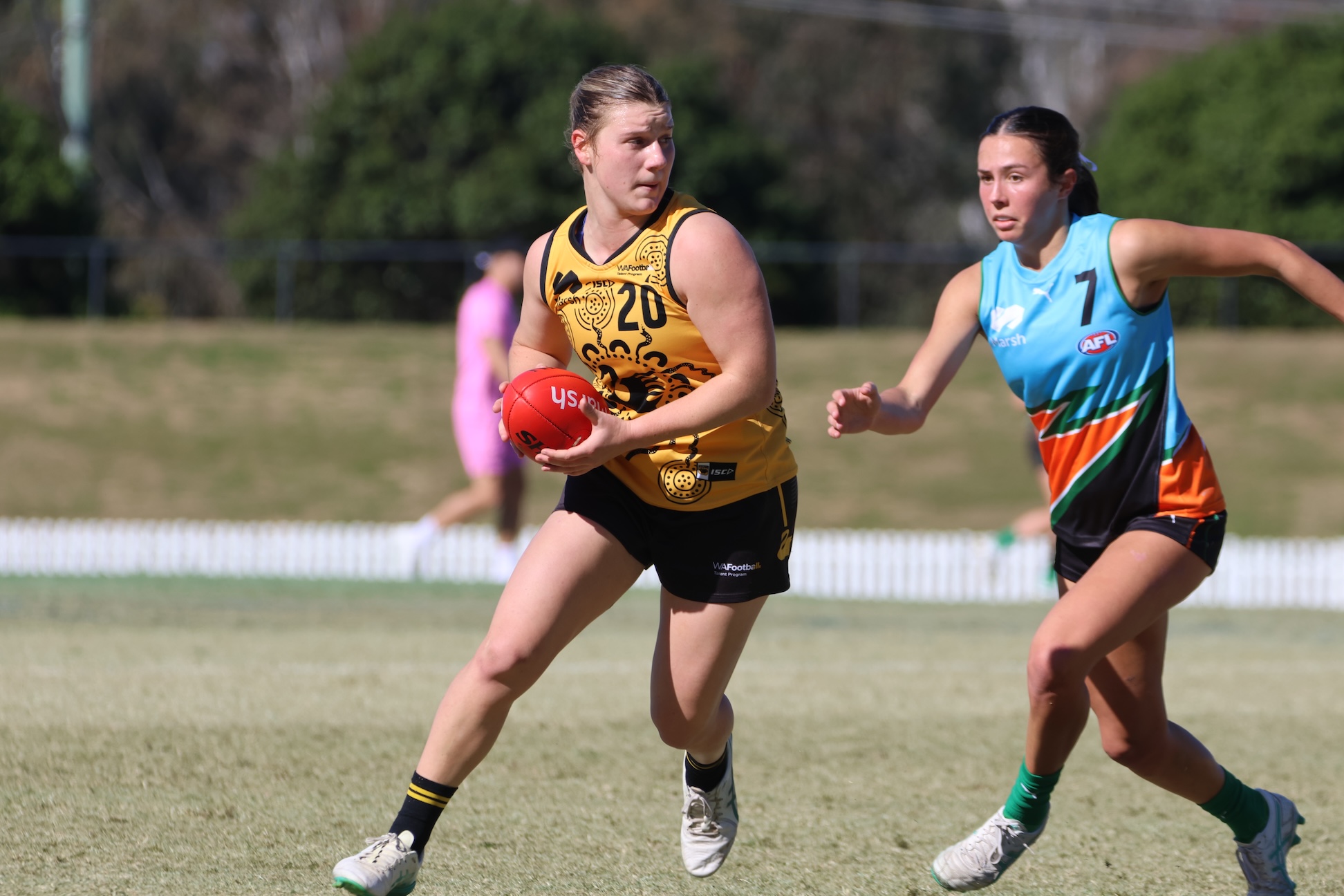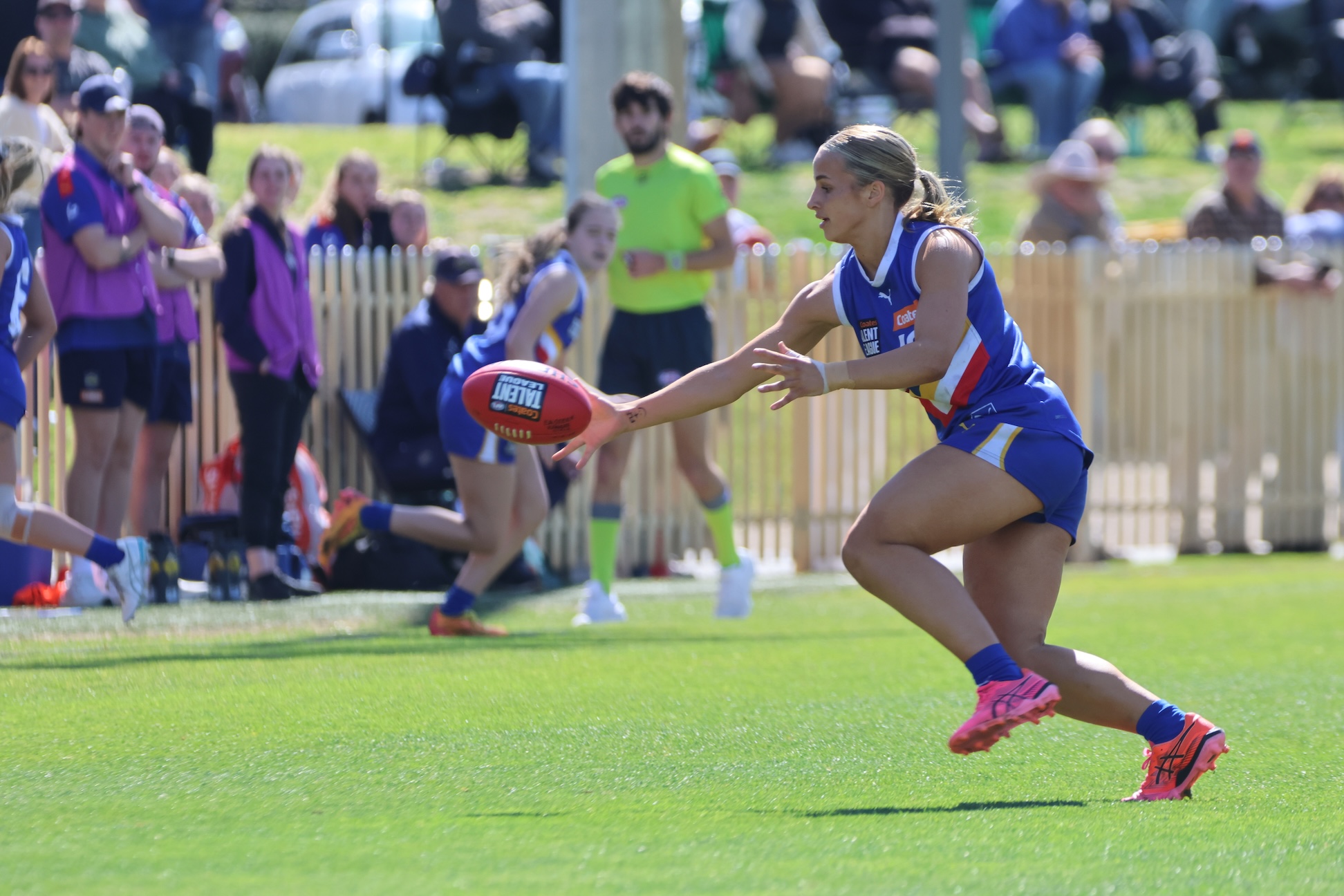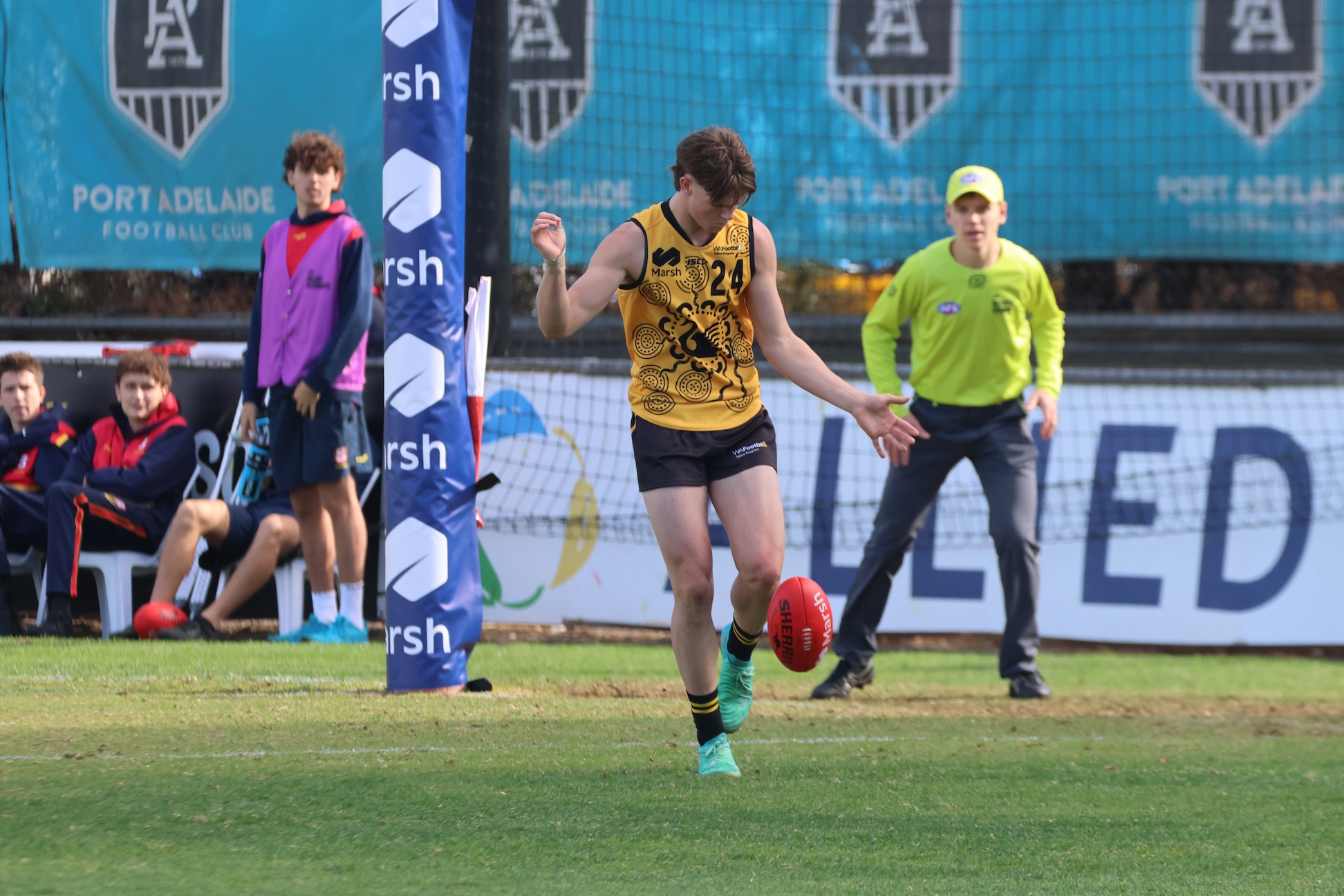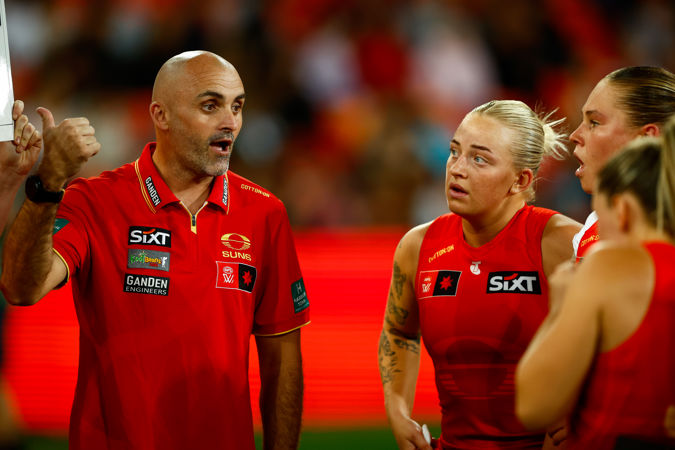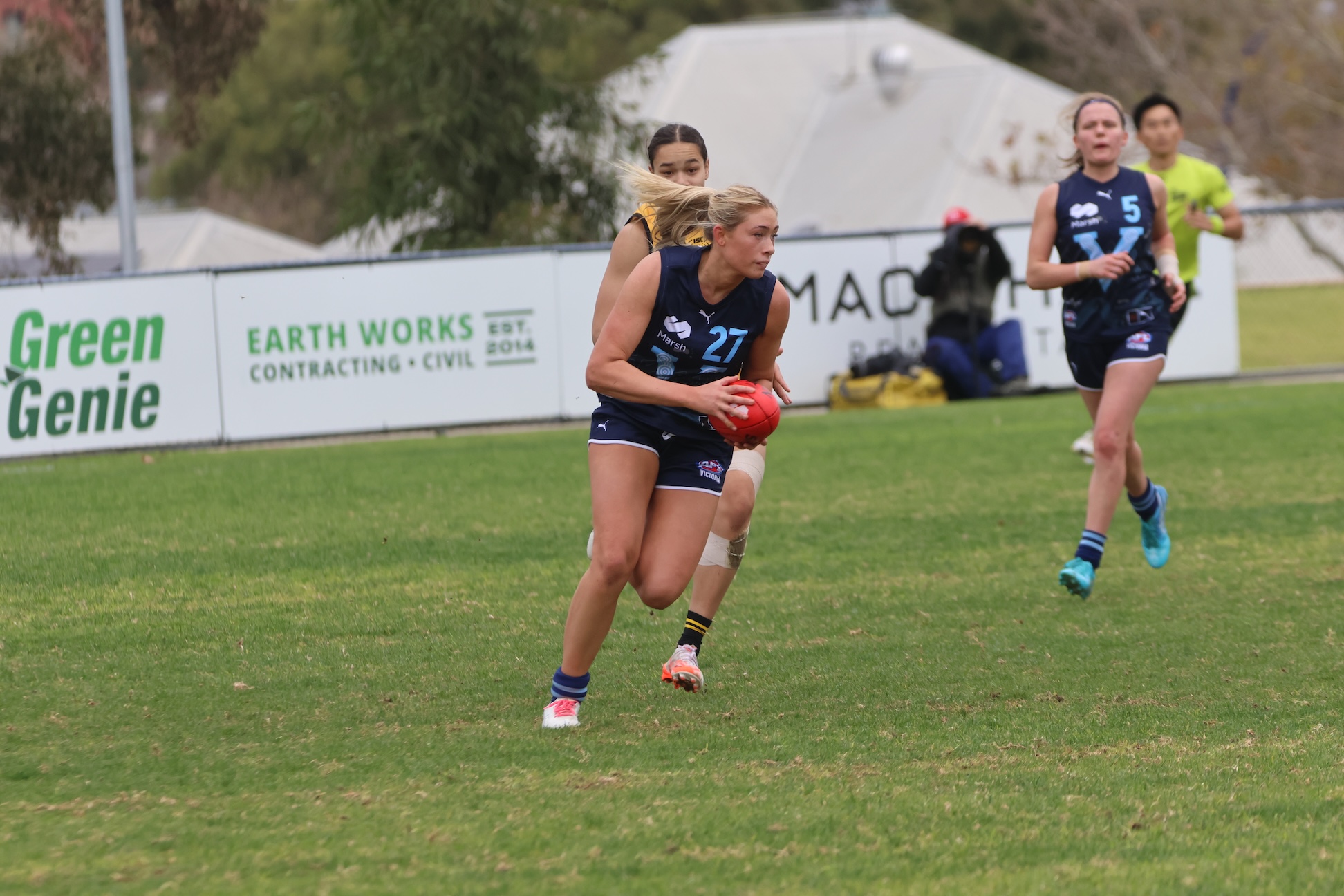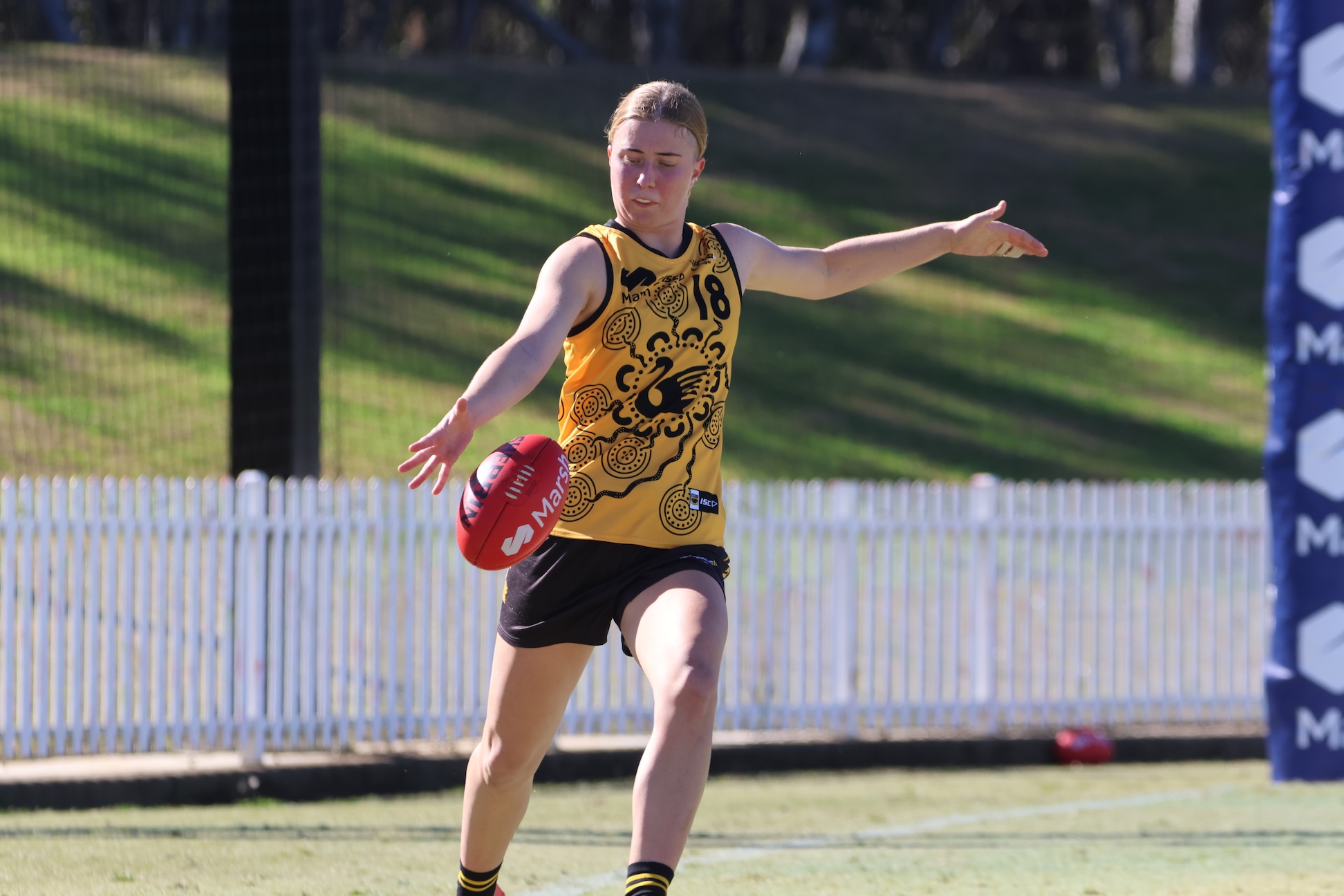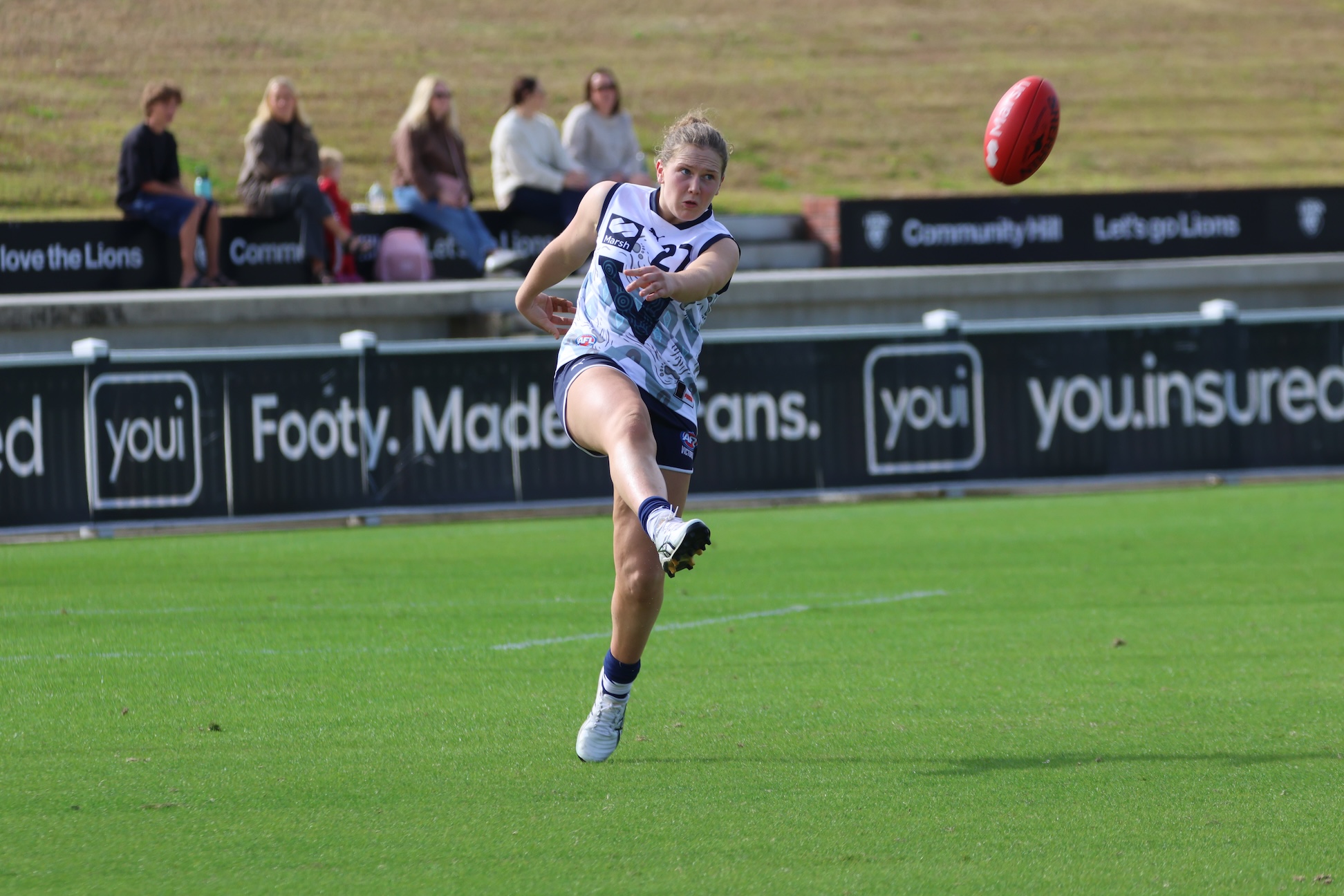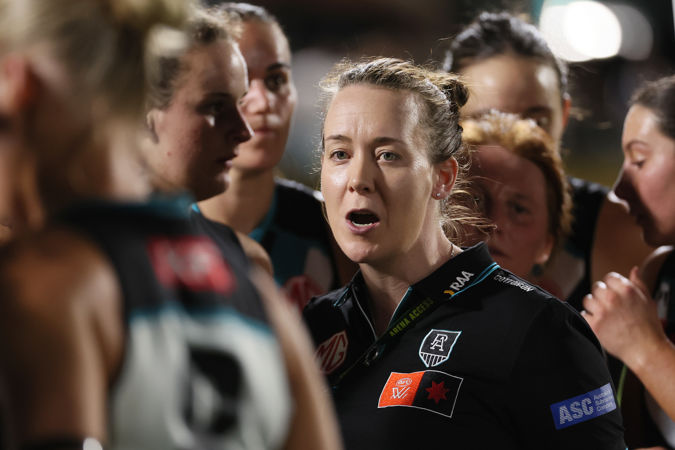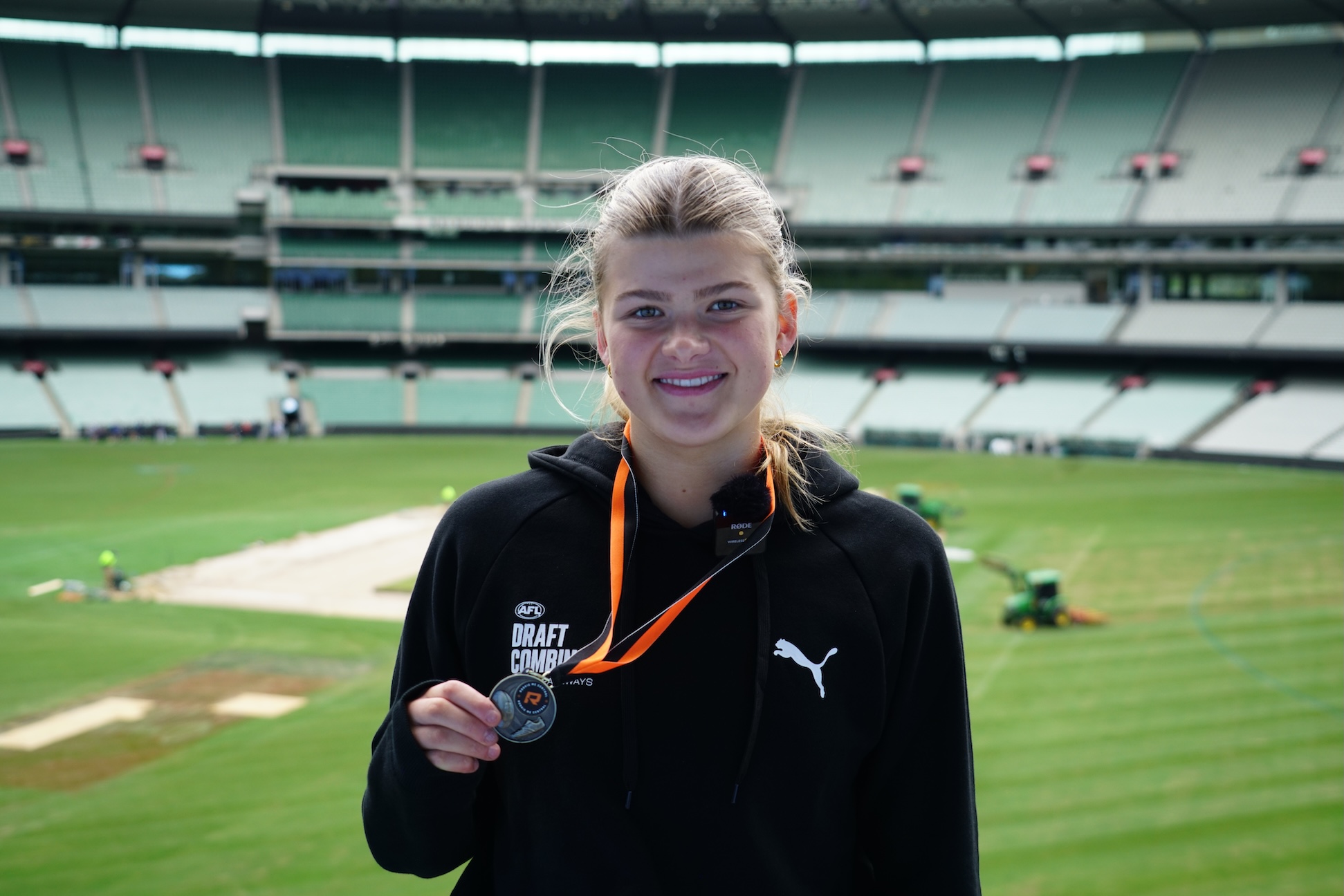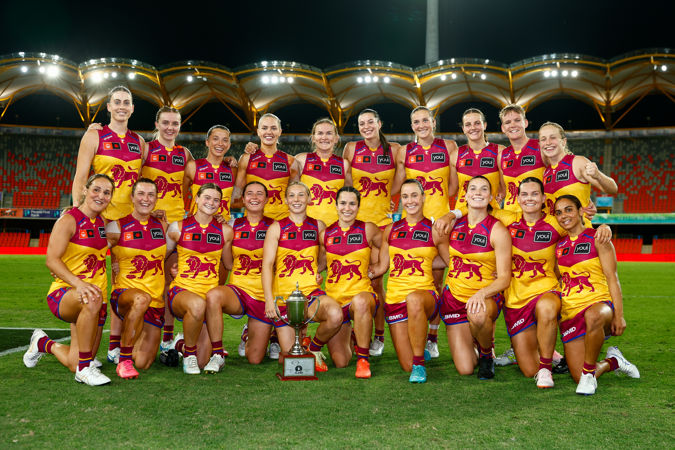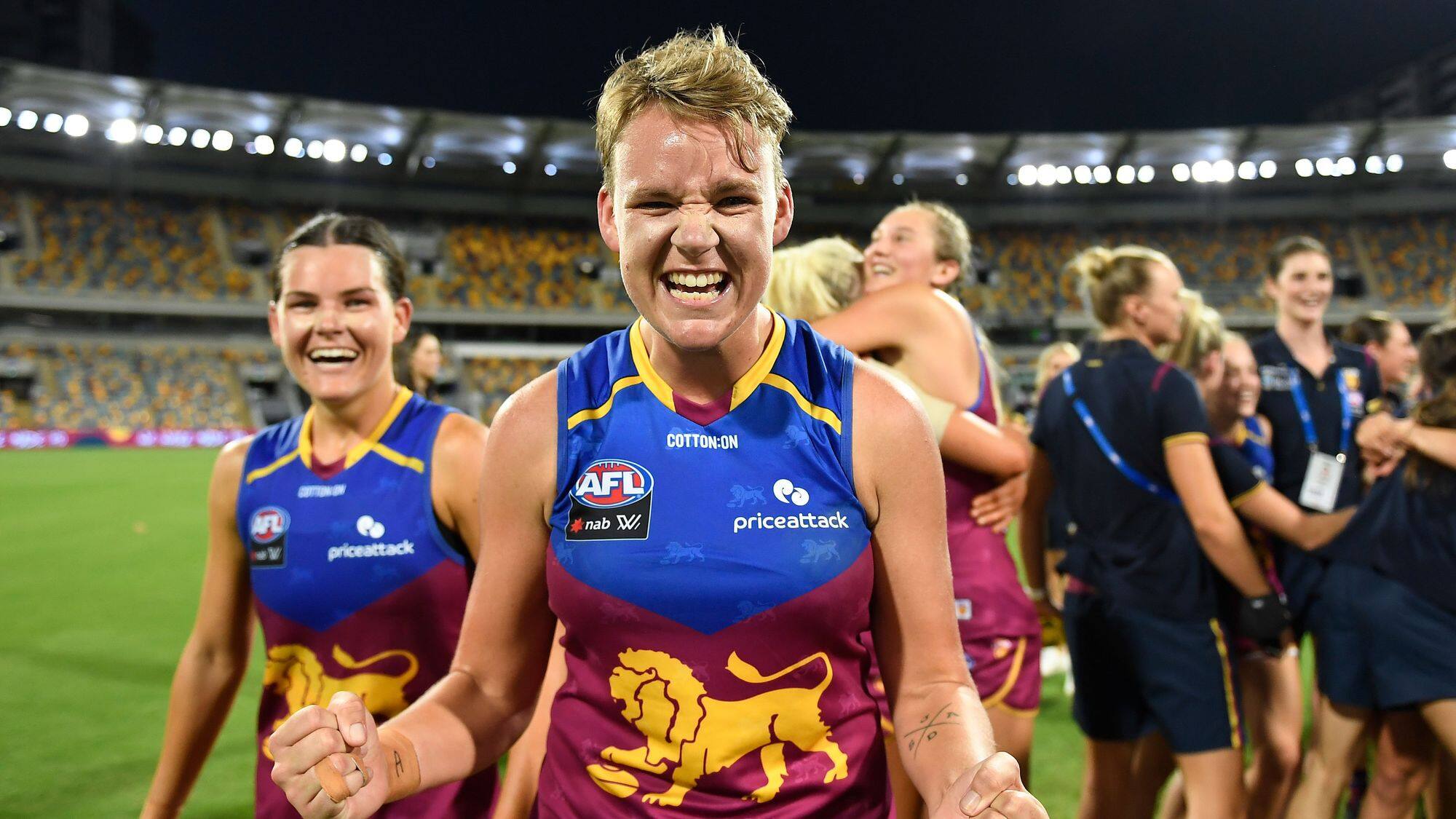Photo courtesy of TAC Cup
1. Joshua Schache – Vic Country (199 cm, 96 kg key forward)
Schache has to be considered the number one pick by now – partly due to performance and partly due to position. If Schache is still considered a top three prospect come draft time, with Carlton, Brisbane and potentially Gold Coast (if Dixon leaves) all desperate for a franchise key forward, it would be very surprising to see him overlooked for the number one slot. As a player he is a powerful key forward with a high endurance base, an excellent set shot and a fantastic mark of the ball. He is a one grab mark and capable of really rooting himself to the ground and giving himself a foundation in contests to resist contact and avoid being moved off the ball like a Peter Wright type was last year. The knock on Schache is, like a Tom Boyd type, that he’s not very quick, often struggling to create separation and has a large turning circle. At ground level he is not going to turn around his opponent. In general, Schache favours the game being played in the air as opposed to the ground – while the modern day key forward often competes in both dimensions. That said, his dominance across the championships has been unrivaled by any key forward over the last few years so he rightly demands consideration for pick one.
2. Jacob Weitering – Vic Country (195 cm, 90 kg key defender)
Weitering is another player clubs will be swooning over. It is rare for a key defender to be considered this early but if there was one to buck the trend, it is Weitering. He is such a well rounded player. Aerially he excels, picking up the flight of the ball early and positioning himself well. He picks the right times to zone off and intercept and when sticking to his man and rarely loses one on one with his ability to ground himself, keep balanced and mark or spoil exceptional. By foot, he nails targets and makes the right decisions and defensively he’s got a proven record of shutting down his opponents despite their natural gifts. Aerially he’s better than his opponents. At ground level, he often beats them – there would be very few forwards who could get on top of him, with the exception being the ones who combine athleticism with football IQ, and they’re a rare breed. Weitering while athletic isn’t exceptionally quick or agile, and could find himself giving away space to those who can match him for smarts and beat him for pace.
3. Aaron Francis – SA (192 cm, 89 kg utility)
Francis is really the unknown of the crop. What he’s shown so far this season is special, however he lacks a defined position to rocket him up the draft order. Do you want to take an undersized general defender with a top 3 pick in the hope that he becomes a midfielder? He’s not really a key defender nor is he a key forward. The query is whether he’s just that good off a back flank to justify it, and whether there’s a strong chance he can move into the middle. By foot Francis is exceptional – with elite vision, decision making, range and penetration. Aerially is where he really excels though. On the lead he’s clean and creates separation. In defence his intercept marking is elite and he’s able to clunk pack marks too. Athletically he’s got an excellent leap and is elite for agility. The question on Francis as a defender is his style of defence. He favours sagging off his direct opponent and backing his natural read and leap to effect or neutralise the contest instead of physically engaging and close checking. The risk with this style is that an opponent is able to easily create space and separation and secure an ideal position for a one on one. Despite that, Francis is a tremendously smart and skilled footballer – and is a safe bet to improve any club he’s at.
4. Jacob Hopper – NSW (186 cm, 82 kg inside midfielder)
Hopper is the dominant inside midfielder of the crop. As a pure extractor, there is no better. He is courageous, ruthless, disciplined and hard as nails on the inside, regularly putting his head over the ball and just extracting the ball with force. Not only is he excellent at possessing the ball, but he’s also very good at transitioning that hard ball get under pressure to a consolidated possession for his side, with his awareness, vision and skill by hand in traffic exceptional. He not only finds teammates in space but puts them there with his creative work. He also possesses some real defensive work ethic, laying tackles both in volume and quality. The knock on Hopper is his outside game – it is not there yet, nor are his footskills with his ability to create and execute while in space lacking. For a player so dominant on the inside, he can cover this weakness but ideally he must continue to work on his spread and outside hurt factor. That said, his pure ball winning ability is unparalleled, and even if his outside game remains average will still allow him to make the grade at AFL level.
5. Callum Mills – NSW (188 cm, 78 kg inside midfielder)
If Hopper is the most dominant inside midfielder in the crop, Mills is a close second. It is unfortunate that we have not seen much of him this year and that he missed the championships, but he has enough exposed form to already be considered a top prospect. Like Hopper, he’s exceptional on the inside. He wins his own ball, reads the ruckman’s tap well, has great spacial awareness especially under pressure and distributes by hand well – however he doesn’t feel as supremely dominant on the inside as Hopper. However, aerially he has a point of difference with his overhead marking ability exceptional. While he finds the ball outside the contest he’s not as effective a user of the football, which when combined with his average speed means that while he is able to get it outside and accumulate, at this stage he is not someone you particularly want possessing it on the outside. That said, he is a high character individual accumulates week in week out and hurts the opposition just by his sheer ability to win disputed football. He is the kind of player who is very likely to make the grade by sheer virtue of his standout inside dominance.
6. Matthew Kennedy – NSW (187 cm, 84 kg inside midfielder)
Matthew Kennedy is a composed inside leaning midfielder. He cracks in hard and wines his own ball, and even in traffic and under pressure he remains composed. He possesses good running patterns and accumulates well, while forward of centre he has got some real ability to hit the scoreboard and overhead ability to make him another marking target. Athletically he is sound, working hard and ensuring he gets from contest to contest. Defensively, he works both ways with his tackling pressure a highlight, combined with his physical dominance of the play. He quite possibly is the hardest hitting midfielder in the draft; like a bull. The knock on him is his kicking. He possesses a capable opposite foot though is technically has a raw and ineffective kick at times. The scope is there, he’s got the awareness and poise but just lacks the execution and that’s what he will need to improve on to be a chance at making the grade.
7. Charlie Curnow – Vic Country (191 cm, 95 kg key forward/inside midfielder)
Charlie Curnow is one of the most underrated prospects in this draft and partially due to an unfortunate dislocated knee that forced him to miss the championships, has flown under the radar strongly. While many salivate over his highly rated teammates Rhys Mathieson and Darcy Parish, Curnow has quietly gone about his business rather impressively. Curnow is a strong-bodied midfielder who has starred up forward because of the lack of key forwards at the Falcons. In many games, Curnow has kicked a handful of goals and then gone into the middle and won plenty of inside ball. His style is not too dissimilar to a Jack Darling, Jake Stringer or Jarryd Roughead type with his combination a dominant forward presence and physical and athletic inside grunt work through the middle. There is scope for Curnow to develop a similar game to Josh Kennedy at the Swans should a club decide to play him as a pure inside midfielder. But forward of centre is where I think he has the most potential, as, like most kids who have a late growth spurt (which Curnow has), he has got the height of a forward but athleticism and nous of a bloke much shorter. With his rate of development both physically and in football terms, it is likely that Curnow continues to progress and becomes one of the best players from this draft.
8. Darcy Parish – Vic Country (181 cm, 73 kg outside midfielder)
Darcy Parish is an exciting outside leaning midfielder. He is just classy in every regard. By foot he possesses a penetrating and technically sound kick with the ability to hit targets over any range. To compliment that, he possesses excellent decision making skills and vision. He is also able to create and penetrate. Not only is he an excellent kick, but he’s a solid runner of theball too. He sees the angles and the gaps and decides appropriately when to run the ball and break lines which is how he avoids being chased down despite not being a speedster. His inside game is on the improve, having gone from a pure outside midfielder to one with an inside game. He has a decent read of the tap, is clean at ground level and moves well through traffic. He is composed under pressure. His positioning and running patterns are good, which allows him to accumulate the ball well. While forward he has shown a tendency to put himself in dangerous positions and while he hasn’t announced himself forward he has shown scope to be a player who is dangerous resting there. Occasionally, Darcy floats around for the easy possession but he has been improving that over time. The major knock on him is that he is a bit of a jack of all trades but master of none. He is a good kick, he is reasonably athletic, he can run the ball and he can win his own ball but he’s not dominant in any facet. He is not elite kick, he is not a pure athlete, he is not a pure line-breaking midfielder, his inside game is a bonus but not something that could define him and he is not a defensive workhorse. He is good, and he is likable – but does he have anything that will make him anything more than a handy role player at the next level?
9. Callum Ah Chee – WA (182 cm, 71 kg midfielder/small forward)
Callum Ah Chee is the mercurial and exciting player of this draft crop. He is often typecast as your typical indigenous livewire crumbing forward or line-breaking outside midfielder but in reality, he is none of that. He is a pure footballer. He possesses an excellent vertical leap and a hunger to get as high as possible and as a result takes some excellent pack marks. His hands are sticky and for his size, he’s an excellent contest mark – like Rioli or Wingard. By foot he is exceptional too, possessing a bullet-like, creative and accurate kick off both feet and by hand he distributes well. With ball in hand he’s very aware and composed. When forward, he can pop up in the right spots but it’s not what defines his game. He is capable of breaking lines but it is not something he does as regularly as you would expect, backing his skills to do the work. He lacks a real inside game, with his only contested ball winning coming in the air. While his kicking is excellent it lacks range, with Ah Chee excelling over 30-40 metres maximum. He also struggles with consistency and defensive work ethic but as a high character kid he will likely learn quickly about what’s required in an AFL system. As a player he shares a lot of similarities with Chad Wingard.
10. Rhys Mathieson – Vic Country (185 cm, 79 kg inside midfielder)
Rhys Mathieson is a natural footballer – someone who is not perhaps as smooth or athletic as most in the top end of the draft but makes up for that in smarts and courage. He is the kind of player that while he won’t go top five because he is in the lower half for athleticism and has a mediocre kick, you can be sure that he’s going to make the grade and play a lot of AFL football. He reminds me a lot of Jordan Lewis. He is not someone who has the prototypical wide framed and big bodied inside mid and doesn’t win his own ball through pure strength, but through a natural read of the ruckman’s tap combined with smart ground level play and decision making in congestion. He has got a natural feel for the inside that you cannot teach. Not only that, but he is a ferocious footballer and the first to put his head over the ball and attack it at full speed, pushing through anyone in his path. This translates to every part of his game – which is full of energy. At ground level he is clean and he distributes by hand well. He is a high level accumulator who while an inside midfielder is capable of linking up outside. There are two primary knocks on him – athleticism and kicking. As an athlete he is relatively slow without much agility or a good leap, however despite lacking agility he still moves well in traffic as he is very aware of his surroundings. By foot he is inconsistent and lacking creativity, often taking the safe option and rarely breaking open the game by foot. Despite that, his sheer will to win the ball and dominance inside should set him up for a high quality, albeit scrappy, career.
11. Kieran Collins – Vic Country (193 cm, 94 kg key defender)
Collins is the kind of player supporters would love to have at their club, but perhaps they might not want on draft day. He is not flashy or exciting – but he is disciplined. He also plays his role, which is vital. As a pure stopper he is exceptional. One on one he is able to outmuscle and outbody his opponent and effect a spoil or win the mark. He rarely loses. He wears his opponent like a glove, giving them very little space all day and is quick to react to their moves. His reaction time and speed of mind make up for his lack of pace – which is a weakness. He is not incredibly quick, and at 193 centimetres you like those shorter defenders to be able to cover the shorter and more athletic forwards. As a result of his speed and mediocre turning circle, he does occasionally give away some separation. However, due to his high work ethic, discipline and technique he’s usually able to neutralise his opponent. Collins places many second efforts and loves the one percenters. Not only that, but he’s a smart footballer and seems to buy into the game plan. He knows when it’s appropriate to leave his opponent and zone off to intercept or cut across a contest. His intercept marking is handy, as is his willingness to run and provide an option in the transition. By foot he is reliable but not damaging. While closing speed and size are the new fads for defenders, there’s still a place for the honest, hard working and disciplined defender in the game and Collins is that. He is a bit like an early career Ben Rutten with more of an offensive game.
12. Ryan Burton – SA (191 cm, 90 kg general forward)
There are very few people who have seen Ryan Burton live and it is a privilege. He is a fantastic footballer. A year ago, the only knock on him was height; he was listed at 191cm then, and still is now. Whether he has grown or not over the last year is not known – but any growth improves his stocks as he’s a bit of a ‘tweener’ at the moment; inbetween key forward and small forward size. Combined with his exclusively forward game and he’s not an ideal height – but it is still something he can work around; plenty of the best forwards have been between 6’3 and 6’4. The other unfortunate knock on Burton is his horrific broken leg. He broke it mid last year and a year later, still hasn’t played such was the severity of his injury. Broken legs are often career impacting injuries, and drafting a player who will have not played for the best part of a season and a half is a serious risk, let alone factoring in the long term effects of that injury. But if there was a player worth drafting despite all those question marks, it is Burton. Having made his SANFL league debut at 16 in his bottom-age year, he didn’t look out of place in the North Adelaide senior lineup. In the first game of last year’s championships, he was the dominant player on the ground and kicked five goals. At this stage, he is a lead up forward – and his leading patterns are elite, constantly putting himself in dangerous places, double backing and working his opponent over. To compliment that leading game, he is exceptionally clean at ground level and in the air, possessing sticky hands. By foot, he is fantastic, being able to spot up targets and really penetrate. His set shot for goal is very reliable and he possesses a long range kick, capable of knocking them down from well outside the ark. At this stage he hasn’t shown a major contested game nor much scope for the midfield; he is the height of those forwards who pinch hit through the middle like Roughead and Darling (as well as Curnow from this year) but does not have the frame or game for that yet. But in time it may develop.
13. Harry McKay – Vic Country (200 cm, 85 kg key forward)
Harry McKay is one who’s dividing opinion. Like Weideman, it seems most journalists/experts rate him really highly – while the amateur draft watchers just do not get it. I sit in the middle, but I am looking for an excuse to jump on the bandwagon – and I must give credit to what he’s achieved this year. For one, he is a late December birth. If he was born eight days later, he would not be eligible until next year. With what we have seen of him thus far, imagine how he would play with another year to develop before being eligible? Josh Schache, the consensus number one forward in the draft, did not impose himself in his bottom-age championships. Some key forwards show signs, but rarely do they dominate. If born eight days later, these champs would be McKay’s bottom-age ones. And he is likely All-Australian. He is 200 centimetres tall, and he has got a good leap as well as being quick and very agile – unfairly so for a key forward. He is just a smooth mover – below his knees he is clean, in traffic he is smooth and his reflexes and sharpness are fantastic. Most 200 centimetre players lumber around – even the good ones. McKay does not. In many ways he has got the dexterity, sharpness and athleticism of someone three or four inches shorter, at an elite height. His hands are clean overhead, being a one grab player, and he is a lovely kick of the ball while possessing a capable right foot if needed. When he has the ball, you just feel like something is going to happen – and it usually does. But where my question marks arise is from where he gets the ball – it is often between the arcs and not inside 50. This could be by virtue of being asked to play a more up field role, but when he is inside 50 he doesn’t seem to have great leading patterns either, possessing the ball either via a mismatch, at ground level or by just being in the right place at the right time as opposed to really earning it and demanding it on the lead. At this stage he is also not a proficient pack mark; he is not going to crash packs and clunk them – but he does protect the drop zone well and take the ball at the highest point, which combined with his clean hands allow him to take plenty of good grabs under pressure between the arcs. It is a bit similar to how Ben Griffiths is an excellent target between the arcs but doesn’t carry that over as much inside 50. Right now, there is a lot of Ben Griffiths in him, but there is just a little bit more to like than when Griffiths was a junior, especially considering his young age. There potential for him to grow further given his age, and the goal for McKay should that happen would be to resist the general trend of becoming more cumbersome with extra height and retaining his current ground level excellence and athletic qualities while gaining the strength and reach benefits of that extra growth.
14. Ryan Clarke – Vic Metro (180 cm, 77 kg outside midfielder/forward)
Ryan Clarke is a versatile midfielder who is just as dangerous off a forward flank. Favouring the outside, he is a good run and carry type of outside midfielder without being a wide receiver; when outside he receives the ball closer to the contest and uses a powerful first few steps to emerge from traffic and break the initial line. He has also got a good inside game, with his hands clean and his read of the tap also good. His clearance game is improving every week. That said, his inside game is a compliment to his outside game and not a defining feature. Athletically, Clarke is quick but not electric and has good agility and even better evasion. His spacial awareness is solid. When forward Clarke positions himself in dangerous spots and has good goal sense, regularly executing difficult shots. Defensively he works hard and applies real pressure. His tackling is also a highlight laying quality tackles in volume. By foot he is normally good with some real vision and decision making but inconsistent at times and technically a bit shaky. He occasionally misses targets he really should hit especially given his vision, creativity and decision making. The other knock on Clarke, like Parish and Partington, is that he is a bit of a jack of all trades and master of none. He is able to do most things in football to a reasonable standard and his primary strength is in the consistency of his attributes. However, it is also a weakness; he lacks a defining trait that that stands out and carries his game.
15. Josh Dunkley – Vic Country (189 cm, 85 kg inside midfielder)
Josh Dunkley is the prototypical big bodied inside midfielder of the draft. Unlike Mills and Hopper, who are not that much smaller than him, Dunkley wins his ball not by feel, skill or touch but by physical dominance. He is an imposing player. He is strong through the core and makes it very difficult to move him off his path; if Dunkley sees a ground ball and goes for it, you are not going to bump him off that like you could most players, you’re going to have to beat him to it. He compliments this physical and powerful brand of contested ball winning with a reasonable read of the ruck tap. As well as thriving in contested ball situations, he thrives in other physical situations too – he is a marking target and someone who will win his share of one on one targets and hit the scoreboard but he’s also a ferocious and volume tackler. He anticipates the opponent’s decisions well and is able to position himself to effect a tackle the moment a player receives the ball, hence his high numbers despite not having speed or agility. However, outside of physical situations Dunkley is limited. He does not find the ball outside, often positioning himself poorly and by foot is shaky. He lacks penetration and technique while also making poor and rash decisions and having limited vision – with ball in hand it’s like he has blinkers on and only sees what is directly ahead. Under pressure he is prone to panicking and lacks composure in general. Athletically he is relatively slow and lacks agility or evasive moves. He does not possess elite endurance either and will need to improve this given his limited style – it is imperative he is able to effect every stoppage. As a player you know what you’re going to get with Dunkley, he’s a player who is all about the physical side of the game and how he possesses the ball. And it is a valuable role in a side. But outside of that, he is limited.
16. Ben Keays – QLD (185 cm, 82 kg balanced midfielder/forward)
Ben Keays is the best academy player the Lions have produced; certainly the most natural footballer. He is a midfielder who can really hurt a side forward of centre, with his forward ability so good that if he doesn’t thrive in the midfield, he has got the scope to thrive forward. One-on-one he outbodies and outpositions his opponent, rarely losing a marking contest to a similar sized opponent, while when forward he acts as another threat on the lead, positioning himself dangerously partially due to a lack of defensive ethic – he spends his time chasing his next disposal and not his man. He is capable of winning his own ball and receiving it outside however he is not dominant on the inside, merely capable. It is not the kind of inside game that will carry him at AFL level. Likewise, as the best player on the Queensland side, players often actively look to feed him the ball outside the contest which results in inflated possession counts and possessions in occasionally unfavourable positions. By foot, Keays is reliable but not fantastic, often kicking floating balls without penetration, as well as lacking any semblance of a right foot. Athletically Keays runs all day but is not particularly quick or agile.
17. Luke Partington – SA (182 cm, 75 kg outside leaning midfielder)
Luke Partington is an outside midfielder with a capable inside game. He has been in the system a while, having played a role in South Australia’s championship win last year, but more as a pure outside midfielder then. This year he has added an inside string to his bow, showing a natural feel for the inside and a good read of the tap. He has a good clearance player and has some reasonable spacial awareness. However, the outside is still Partington’s specialty. His running patterns are superb, with his positioning constantly dangerous; he always provides an option for the ball carrier. With ball in hand he is reasonable, with his kicking solid without being spectacular. His vision is good; he scans the ground before disposing and always looks to take the ball through the centre if possible. He is quick without being electric and likes to take on the game and break the lines – he has also got handy burst speed emerging from stoppages. He possesses reasonable agility and evasion. Defensively he is capable of running both ways and applying tackling pressure. The issue with Partington is his lack of a stand-out trait. Not dissimilar to Clarke and even O’Kearney in being jacks of all trades but masters of none; he is a good kick, quick, agile, has an inside game, is relatively clean and can defend but he’s not dominant in any – there is nothing to carry and define his game. He does not hit the scoreboard enough, as well as lacking positional versatility. With all that said, his production has been superb at any level and he is still a good bet to improve a side, just perhaps not the kind of player to build around.
18. Riley Bonner – SA (191 cm, 80 kg general defender)
Normally a utility who could play anywhere, Riley Bonner has found a niche off half back this season. Despite being 191 centimetres, he is not a key position player or close to that – he plays smaller. What defines Riley is his kick – his left boot is elite, with superb penetration and range. His right boot is also very, very handy – and arguably still better than the preferred foot of some. He makes excellent decisions and has superb vision, regularly picking out the correct targets. To compliment his kicking game he possesses an excellent running game, with good speed, spacial awareness, evasion and agility allowing him to break the lines and really run the ball. He is the kind of player that gains you 30 metres in run and then 50 metres by foot. He has an intercept game but it’s still developing – flashes of it appear every now and then but he is not someone you would want as that primary interceptor yet. With his height and leap it should develop over time. With great hype comes a few knocks, and Bonner’s weaknesses are clear. He is outside. Very, very outside. He needs to be fed the ball to possess it and really only wins it in space. In the modern congested game you want every player to be able to win the hard ball, especially in defence when there are 30 players in the defensive 50 at one time. Given league football is a lot more high pressure and congested than champs football, it remains to be seen whether Bonner’s kicking holds up with far less time and space. But the scope is there for it to. The other knock on him is his defensive game. He is a defender who struggles to defend at times; he is played there because his offensive game is far more damaging from the back half. He loses his man too much, struggles to apply pressure at time and in general lacks some defensive work rate. The AFL system should sort this out but it’s still something that will prevent him from impacting early; he won’t be selected until he’s capable of locking down on a direct opponent at AFL level. There’s no such thing as an offense only defender these days.
19. Darcy Tucker – Vic Country (184 cm, 78 kg small defender/outside midfielder)
Darcy Tucker has been the real slider this year. At this stage last year he looked like a potential top selection, having shown really promising signs in his bottom age championships. But he has not seemed to develop much since – and in fact, seems to have had a worse championships than last year. When looking year to year improvement in players, there should be often an assumption of strong growth from year to year (and within the one season) will continue as they enter the system while those who do not improve much will continue to only make marginal improvements. Players like Marcus Bontempelli and Jackson MacRae displayed immense improvement over their junior careers which had an impact on where they were drafted, for example. And they continued that rapid rate of improvement into their first and second AFL seasons. That is the question on Tucker – he does not seem to have improved. Nor has his inside game developed which was always the knock on him. But that is enough of the negatives – he is still a well liked prospect and for good reason – he is quick and loves to break the lines as well as possessing excellent kicking. Clubs are always looking for outside midfielders who will really add to their run and carry and Tucker does that, as well as deliver and execute with precision. His evasive moves are also excellent. He’s also got the versatility to play off half back, having played his best football there last year. He offers the added option of being able to play as the designated ‘quarterback’ type elite kicker if a team needs, and may well start his career there before moving to the midfield. Tucker’s temperament is another issue, having been yellow carded in a championships game for a brutal strike on Stephen Tahana off the ball.
20. Wayne Milera – SA (185 cm, 75 kg small forward/wingman)
Wayne Milera is another who’s slipped under the radar, but has some real skill about him. Having played the season at league level for Centrals in the SANFL, he’s got experience at a high level and against bigger bodies, holding his own. By foot he is both creative and skilled, especially over short to medium distance. He has got excellent vision, makes good decisions and is composed. While an outside player predominantly, he is freakishly good in traffic, being borderline impossible to tackle. He just weaves his way through traffic with such grace, seemingly always aware of who’s around him and where his teammates are. He has also got really quick hands so can fire off a handball when under pressure before you even notice. When in possession his spacial awareness is his greatest attribute. He is quick but not elite for speed, however with his decision making regarding when to run the ball he looks it. His agility and movement also makes him look quicker than he is. He is also a very capable link player around half forward, regularly leading to the right places and finding space to take a clean mark and then use his skills to make an effective entry inside 50. The knock on Milera is his lack of a clear and defined role – he’s not particularly an outside midfielder, rarely accumulating enough of the ball to justify a full time midfield spot, nor does he break the lines like you would expect someone like him to, but when forward he’s not a goalsneak either; while capable of hitting the scoreboard, he does not do it regularly and remains a one or so goal a game player. Another issue with Milera is his defensive side and strength. When tackling he does not seem to be able to really stop the ball carrier, with his tackles regularly broken and evaded. He is also knocked around very easily, seemingly lacking strength and balance at times.
21. Harley Balic – Vic Metro (186 cm, 80 kg outside leaning midfielder/small forward)
Harley Balic is one of the most exciting prospects in the draft. He comes from a basketball background and it is very clear in the way he plays; he possesses that typical spacial awareness that most converts share; he always knows what’s around him and what he can do. He is also a high IQ player, positioning himself well to find the football and when in possession displays good vision, composure and decision making – although is occasionally a bit conservative by foot, favouring lateral movement over taking a risk. He also lacks range and penetration in his kick, often kicking loopy moonballs. On the inside he is developing well, learning how to read the tap and win the hard ball. What is also impressive is his quick handballing out of the contest, it is normally effective and finds a target. When forward he is dangerous, with solid forward IQ and positioning and good hands overhead; he is a one grab overhead mark. The issue forward is his set shot conversion, which leaves a lot to be desired. That, his conservative nature and lack of penetration by foot and his athleticism are his weak points; while he is a smooth mover in traffic (due to his spacial awareness more than anything else) he’s a very cumbersome mover with a low top speed and even lower acceleration which hurts his defensive pressure and tackling game; it is difficult to feel like you’re under pressure from a bloke you’ll be able to get past easily.
22. Nick O’Kearney – Vic Metro (181 cm, 71 kg balanced midfielder)
On production alone, Nick O’Kearney should be considered an elite talent in this draft. But, production is not everything, which is why O’Kearney sits this low. He is a high volume accumulator and ball magnet who arguably finds more ball than anyone else in the crop. An exceptionally hard working player, he has got a good balance between inside and outside game. On the inside, he puts his head over the ball and cracks in hard, and on the outside he is a hard running linkup player who positions himself really well. He just always seems to be in the right spots to provide an option for the ball carrier. He also positions himself well behind the ball, often placing himself in the correct position to impact the game. By foot, O’Kearney is solid off both feet, excelling off of one step to either side. However in straight lines he is at times wayward and prone to errors and turnovers. He also is not a natural athlete, lacking exceptional speed or agility. However he is a high level endurance runner and ensures he moves from contest to contest well. While he lacks the athletic or skills dominance to be a truly elite player, with his work rate, accumulation and desire to do the team things he’s the kind of player you expect to make the grade.
23. Greg Clark – WA (194 cm, 88 kg outside midfielder/general forward)
Greg Clark is a really interesting prospect. He did not have the championships he would have liked, often being part of games but rarely imposing himself on them. He has played most of his football as a midfielder, using his elite endurance and work rate to burn opponents and ensure he’s at every contest. However he is slow, possessing a low top speed and not much burst either. Not only is he athletically slow but he’s slow by mind, often taking too long to make a decision or when he has time, making a conservative or incorrect one. Under pressure he lacks composure and is unable to free his arms and distribute like many can when tackled. On the inside he doesn’t display a great read of the tap nor the core strength and foundation to plant himself and bullock his way to the inside ball like the big bodied inside mids can. At this stage, he is very much a tall outside link up midfielder. Given the hype around Clark is regarding what he could become at his height, his lack of a defined inside game is worrying. What I do like about Clark is his potential as a forward, though. He has got the height to act as a target and the work rate and endurance to work his opponent over. He also possesses an excellent lead up and hit up game, being a vital link between the midfield and forwards, while popping in the right spots to hit the scoreboard. In many ways he has the height of a genuine tall forward but the dexterity, touch and ground level game of someone a bit smaller. I think if Clark makes it it could be in more of a Tom Lynch of Adelaide mould as that hard working third high half forward type. Clark is also an excellent leader, with his on field direction and leadership noticeable. If he makes the grade, he’s a future leadership group member.
24. Jade Gresham – Vic Metro (177 cm, 74 kg balanced midfielder)
Jade Gresham is another example of height not being everything. Despite being below what clubs feel is the ideal size, he makes up for it with heart and effort. Another high level accumulator, Gresham combines an ability to read the tap and win the clearances with a handy outside spread and running game. Athletically, he is not super quick, but fast enough to break away on occasionally and break a line, while he also possesses a large tank and work rate, getting from contest to contest. The best way to describe his kicking is reliable, with his decision making sound and execution handy. The issue with it is that too often he favours a conservative or lateral option instead of furthering the play and taking risks. His kick on occasion lacks penetration. This is a mindset issue and something that can be rectified, however. In traffic his awareness is good and he’s able to distribute by hand well. Around the goals he’s displayed some real forward IQ, popping up in the right smarts and executing well. He is a smart footballer as well as a future leader – displaying that in his courageous attack on the ball and willingness to put his body on the line. The knock on Gresham is that at his size he’s neither quick outside nor dominant inside and lacks some hurt factor. At this stage he is a bit of a jack of all trades but master of none, with accumulation the key aspect of his game.
25. Sam Weideman – Vic Metro (196 cm, 91 kg key forward)
Like Harry McKay, Sam Weideman is polarising draft watchers. One half believe him to be a genuinely elite top 10 talent, and the other half do not see the hype. Like with McKay, I am somewhere in the middle. He is a high flying key forward with excellent hands and a willingness to compete and crash packs. He is very much a marking forward at this stage, lacking other real strings to his bow. But that is not a major concern – some of the best forwards in the league are pure marking forwards. Weideman is not as physically dominant as players like Tom Boyd, Jon Patton or Travis Cloke but he is still on the higher end of the contested marking ability spectrum. His leading patterns are solid, however hampered by his below par endurance, which is something he will need to work on at the next level. He is not able to run his opponent ragged, nor does he have the ability to make repetitive hard leads, having to cool off after an intense effort. His ability up the ground is also hindered by his lack of endurance. His athleticism is okay, possessing average speed with some ability to create separation and passable movement. But it isn’t a defining part of his game. His kicking, both for goal and in open play is also okay, being able to hit targets but not someone who’s going to really create by foot. He is able to kick off both feet. The defensive side of his game needs work, with his forward pressure unsatisfactory. This could be linked to his poor endurance however, and with a full pre-season and some real improvement in that regard the flow on effect could be strong; it could allow him to work harder to create opportunities forward and up the ground while also contributing defensively. And that’s part of his allure. Unfortunately, a persistent ankle injury has ruined his season.
The five wildcards to watch:
1. Eric Hipwood – QLD (200 cm, 82 kg key swingman)
Eric Hipwood is really, really raw – but there is a lot to like. If truth be told, he is only a wildcard because I desperately wanted to include 26 players and had to cut one. Linked to the Brisbane academy, his performance against Tasmania in round two of the championships confirmed his status as a top prospect, swinging forward to kick four second quarter goals. He’s very similar to Harris Andrews in a lot of ways – with both their movement, positional versatility and dimensions very similar. Like most kids with late growth spurts, Hipwood moves very well for someone of his size, possessing fantastic dexterity and agility for his height. As a defender, he looks promising, with his ability to close down opponents while competing well below the knees and at ground level while picking the right times to zone off and impact another contest all excellent. He has also shown some aptitude forward with his ground level game and athleticism handy – however he does not look completely natural inside 50, lacking solid leading patterns and a willingness to take pack marks. By foot he’s shaky – however he backs himself to take risks. While he is a bit of a clanger king at the moment it is partially by virtue of him trying to penetrate and break open the game. If he continues to grow into his body and develop that kicking technique, he could actually develop into a very handy rebounder by foot with his mental side strong. At this stage he looks more favoured to be a defender though.
2. Reuben William – QLD (182 cm, 74 kg balanced midfielder/half back)
Reuben William has slipped under the radar but possesses some immense upside. African-born, William does not have a strong background in the game; he is very, very raw but possesses some real ability and upside. He is very quick and also very, very agile – and loves to use his speed and agility to impact the game. Not only that but he attacks the ball some some real courage, cracking in hard and pushing through obstacles in his way. Defensively he tackles hard and with intensity and shows signs of wanting to run both ways. Below his knees he’s very clean and able to distribute quickly. At times he is shaky by foot but from all reports has improved strongly and should continue to do so. He makes the right decisions, it is just the execution that needs a bit of work. Though he is very much a project, his athleticism combined with his hard edge and clean hands as well as strong improvement gives some real hope that he could develop into a excellent player. I am certainly backing him in.
3. Mitch Hibberd – TAS (191 cm, 85 kg half back/outside mid)
Having had a knee and shoulder reconstruction ruin his 2014, Hibberd has come back as an overaged player and really impressed. He is a really nice height to play either half back or through the middle. He has got a lot of AFL qualities – a long, penetrating kick, handy running patterns, some real cleanliness below the knees and a tendency to take on the game and really break the lines. He has also got some real composure and poise with ball in hand and awareness of what is around him. At his size, clubs would be wanting him to develop more of an inside game, but the scope is there. At this stage he could well be in the top 25-30 frame, and is battling with Callum Moore for the honour of being the 19 year-old taken. With some more consistent performances and improvement, he could bolt into first round contention.
4. Gach Nyuon – Vic Country (198 cm, 81 kg ruckman)
Gach Nyuon looks like being the first ruckman taken this year and with good reason. He’s only been playing the game a few years, but has managed to fit two championships into them. Such was his rate of development, he was already playing for Country as a bottom ager. Last year, he was a very raw but talented ruck, whereas this year he’s looking far more complete. He is a little short for a ruckman but makes it up with his high leap, being able to jump over taller and stronger ruckmen – having beaten Parella and Goddard in the championships despite giving away two inches and 20 kilograms. However at AFL level, this approach will not work, he will need to bulk up and learn to compete physically. At ground level, he is clean and by foot he is not a liability, with his improvement in that regard incredible. He is also finding the footy around the ground, at times looking like an extra midfielder as a great linkup option and target. The next step for Nyuon is to bulk up and start impacting the contested side of the game, winning some hard ball, applying tackling pressure and taking some big marks. But the scope is there for him to develop into a really solid AFL ruckman.
5. Keiran Agius – SA (189 cm, 84 kg utility)
The only way to describe Keiran Agius is ‘frustrating’. He has got all the talent in the world but is letting himself down. A member of the AIS-AFL academy, he has gone from playing on the MCG against VFL sides, to missing out on a South Australian side that could only win two games and were crying out for targets inside 50. It all comes down to work rate – he just does not defend. He floats around chasing kicks and giving up the moment the opposition get the ball. His GPS numbers would be half of the other players on the ground. But he is where he is based on incredible natural talent. Some believe him to be the best kick in the draft – he is just so composed and penetrating. Not only that, but he has got incredible goal sense – being able to slot them from anywhere and just putting himself in the most dangerous spots constantly. He is very quick and incredibly agile as well as clean at ground level – but at times tries to be too flashy and loses the ball doing something unnecessary. He has been tried in defence to capitalise on his excellent footskills and run but hasn’t impressed as hoped, and off a wing he struggles to impact partially based on work rate. At the moment his best position is as a forward, which is complicated given he is too short to be a side’s primary target and doesn’t pressure like you want your smalls to do. He also thrives off being that primary target, preferring to lead at the ball and play through the middle, something he likely won’t do at AFL level. Will a club punt on him based on his incredible talent and upside and hope to train the flaws out of him? I hope so. But those flaws are clear, and very detrimental, so I wouldn’t be surprised to see him passed over and asked to fix them in the state leagues – which would be the biggest waste of talent since Dayle Garlett.


